The use of Drones for nature conservation
Over the past years, there has been an intense development of Unmanned Aircraft Systems (or Drones). While in some aspects they can be seen as a potential threat (in terms of sound pollution, potential collision with fauna, and source of disturbance) if handled properly, they can be a useful tool to monitor fauna, habitats and marine environments. Teresa Pastor, EUROPARC project manager, attended a meeting in Spain about the potential use of drones for nature conservation purposes. Here are some of the main outcomes and examples that were highlighted in the meeting.
Some applications in Protected Areas
to monitor HABITATS
- Multispectral images uses to monitor land use and vegetation changes
- Mapping of plants (e.g. invasive plants)
- Monitoring of burnt areas => estimate BAI – Burnt Areas Index
- Plants’ vigour => NDVI – Normalized Difference Vegetation Index => assess the content of live green vegetation. It indicates the state of leaves, chlorophyll activity, and hydric stress.
- BioCarbon Engineering : planting solutions for large-scale ecosystem restoration projects
- Dronehopper – Firefighter drone designed to provide aerial support for wildfires firefighting. This is a high tech solution that permits its adaptability to different conditions, including night operations, required any moment to control wildfires. Each drone has a maximum capacity of loading up to 300 liters of water.
- Phytosanitary controls (articulated arm coupled to drone) (e.g. control Pine processionary moth)
monitor FAUNA and control disease spread
- Monitor the abundance of nesting birds in colonial species
- Monitor disease spread (e.g. tuberculosis in ungulates). The idea is to look for a spreading pattern in order to focus on treatment.
- Detection of poaching
- Disease control vector (e.g Drones that scatter swarms of sterile mosquitoes over wide areas; Zika control)
to monitor MARINE areas
- Census of fauna – Whales , Sea turtles eBee platform (mapping drone)
- State of nutrition of whales by measuring the quantity of blubber with a thermal camera sensor
- Drones which collect drops of mucus from the whales blows that are afterwards analysed in the lab
- Underwater drones – regular inspections of underwater
- Oil spill detection – https://www.maritime-executive.com/article/tests-for-oil-spill-response-drones-underway#gs.kxvieH8
SAFETY
- Life Seeker – Locates missing people using their mobile phones as beacons.
Main types of drones
– – With fix-wings: in a short lapse of time, they can travel a long distance at a high speed. They are very much employed in open spaces and agricultural fields to watch out crops
– With rotary-wings: are best used in forests, which are more inaccessible
– Hybrids with fix and rotary wings – very expensive
– Amphibious drones – Travel underwater and in the air
Moreover, drones are coupled with different types of sensors, among which:
– GPS – GLONASS (Russian satellite navigation system)
– RGB camera
– IR camera
– Multispectral imaging cameras
– Thermal vision cameras
– MicroRadars
– LIDAR – pulses of laser
– Photogrammetry
A EUROPARC Youth Manifesto
Youth gathered in Scotland, first meeting of EUROPARC Youth Manifesto © Alan Smith
Youth taking the Lead for Nature – Shaping Protected Areas & Rural Communities!
This May, youth from across seven countries gathered in Cairngorms National Park to kick-off the process of writing up a “EUROPARC Youth Manifesto”
The final Youth Manifesto will point out the challenges of young people living, learning and working in Rural Communities and Protected Areas, but also offer straightforward solutions how to address those issues at regional and local levels. The results are meant to serve as a source of inspiration for concrete action by decision-makers, public authorities and managers:
- How to design sustainable living spaces not only for, but together with the young generation?
- How to involve and empower young people in decision-making?
- How to encourage young people to retain in or move to rural and protected areas?
- …all this ensuring environmental stewardship and creating more dynamic and future-oriented communities.
Throughout two workshops weeks this May and June the young project participants, aged 16-25, tackle those questions.
EUROPARC Youth Manifesto: What happened so far?
The first workshop ran from 21st to 25th May, during what must have been one of the hottest weeks Cairngorms National Park has experienced in a while. Nonetheless participants arrived ready to work hard and curious to learn about the stories of their peers. The week was all about experience sharing, ideating and drafting the Manifesto. In short presentations throughout the week everyone shared some interesting, informative, inspiring or funny aspects of their own life.
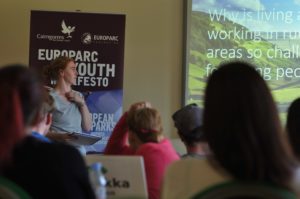
“Why is living and working in rural and protected areas so challenging for young people?” ©Konatsu Hagita
In small groups, participants then worked on identifying challenges and coming up with solutions focused on three guiding topics: “living”, “learning” and “working” in protected areas and rural communities across Europe.
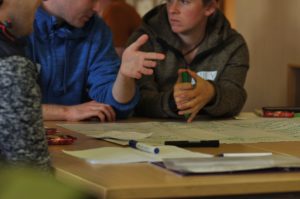
Group works allowed for some focused discussion on ways to. ©Konatsu Hagita
Working groups came up with some very concrete ideas how to support young people in building a good life in rural and protected areas. Besides the clear message to improve infrastructure allowing youngsters to be more connected via transport and social media, the value of engaging young people in outdoor activities, in nature conservation and in living their cultural crafts and traditions were big topics discussed among participants
All the thinking work required some active balance away from the desks – and besides the activities organized by the hosts, participants were quite happy to take care of the fun part themselves.
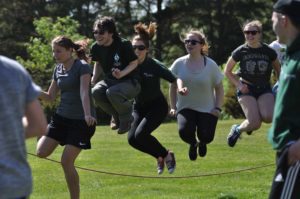
The young people shared not only thoughts but also spent their breaks exchanging outdoor games. With “Finnish Twister” – of which photos remain unpublished – turning out as one of the highlights. ©Konatsu Hagita
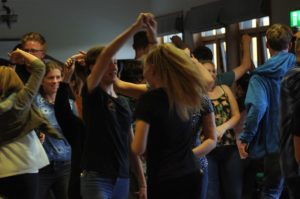
Participants getting a feel for Scottish culture. A local “Feis” band came to play and made everyone try some traditional dances. ©Konatsu Hagita
After a week of dedicated work – and good fun too – a first Manifesto draft was achieved. The key message of the young people is clear:
We are the future yet under-represented in any decisive board; but we are capable and willing to give input and implement changes if given the chance.
Now, what is next?
This June, 17th to 21st, participants will meet again in Kalajoki, Finland for the second project workshop. Youth representatives, who were already part of the drafting group will mix up with some new faces – bringing in some fresh perspectives when finalizing the Manifesto. Besides, youngsters will join workshops about youth involvement in governance and policy-making – a starting point to become an active ambassador of youth interests and the Manifesto back home.
The youngsters will launch the final Manifesto during the EUROPARC Conference 2018 in Cairngorms National Park. They will share their work in a public presentation and be around to talk to you in person about their ideas.
Make sure you don’t miss out: Sign up for the conference here. There is a special youth rate available for people younger than 30 – and until 2nd July the Early Bird fees still apply.
Meanwhile…
Read more on the first Manifesto workshop week in Cairngorms National Park in this article by the Cairngorms LEADER Local Action Group.
Feel free to follow the EUROPARC Youth Manifesto work in progress via Facebook, Twitter or Instagram (@europarc.youthplus).
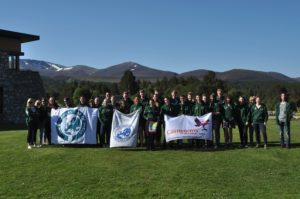
25th of May – Participants sending out greetings to their Protected Areas on European Day of Parks 2018 ©Konatsu Hagita
_______________________________________________________
Who runs the project?
The EUROPARC Youth Manifesto is created as an output of a transnational LEADER project, led by the Cairngorms National Park Authority in collaboration with three Finnish LEADER groups Rieska, Keskipiste, and Ravakka; the Cairngorms Local Action Group; Scottish Natural Heritage; Young Scot and EUROPARC Federation. The project supports the Scottish Year of Young People 2018.